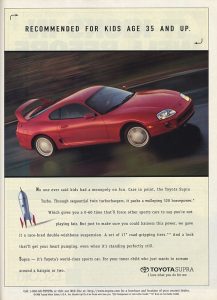Supra.
The first time I heard that iconic name, I immediately thought of the word ‘Super’. I was an unapologetic comic book fan from a young age (still am) so superheroes were already seared into my consciousness, and the connotations were obvious.
A little later in life, I was lucky enough to buy my own Supra, and even more lucky to find one in fairly standard, 6-speed manual twin-turbo guise, just as Isao Tsuzuki – the designer and brains behind the car – intended it. And I discovered that it was indeed Super. Comparatively light of foot next to some of its competitors, punchy, comfortable, refined, and undeniably attractive from virtually every angle, Toyota’s prodigy was a breath of fresh air and became a poster child for the burgeoning Japanese junior supercar stable – backed up by the Mazda RX7, Honda NSX, Nissan Skyline GTR, Nissan 300ZX and the Mitsubishi GTO.
Rather than fading into obscurity at the end of its production run in 2002 as many cars do, the Supra’s popularity instead went from strength to strength. Just as some bodybuilders make massive gains quickly thanks to fortuitous genetics, the Supra’s natural propensity for responding wildly to even basic engine modifications made it a tuner’s dream – and slowly but surely, Supras the world over began to pack on muscle. Their popularity was buoyed even more by a certain car film released in 2001 featuring a gravel voiced and surly bald man. No …….. not Phil Mitchell, the other one. This naturally led to more demand on the used car market from petrolheads wanting to live out their movie car fantasies, and shrewd investors who identified the car’s modern classic potential ahead of the curve.
Cut to today. For the first time in 17 years, you can once again walk into a Toyota dealership and purchase a gleaming new Supra. It’s still got 2 doors and a sleek profile. Despite the bloat which many new cars suffer from, it’s actually slightly lighter than its predecessor. It’s still rear-wheel drive, resisting the modern urge to favour indomitable grip over involvement and control. And it’s still got a turbo-charged straight six under the bonnet, with a slight hike to 335bhp versus the 280bhp (officially……) of the old JDM model and 326bhp of the old UK model. The stars have seemingly aligned, and the boxes are seemingly ticked. If you have petrol in your veins, this is cause for celebration surely? Not quite. Surprisingly, the immediate responses across the internet suggested a general vibe of ………… meh.
As you might expect, car forums and social media (and no doubt pubs) have all been host to lively discussions on the topic since. It appears that the tepid and lacklustre response – prior to any review, which had not yet critiqued the actual abilities of the new Supra – seems to have stemmed from a number of concerns, all of which can be conveniently lumped together under one heading :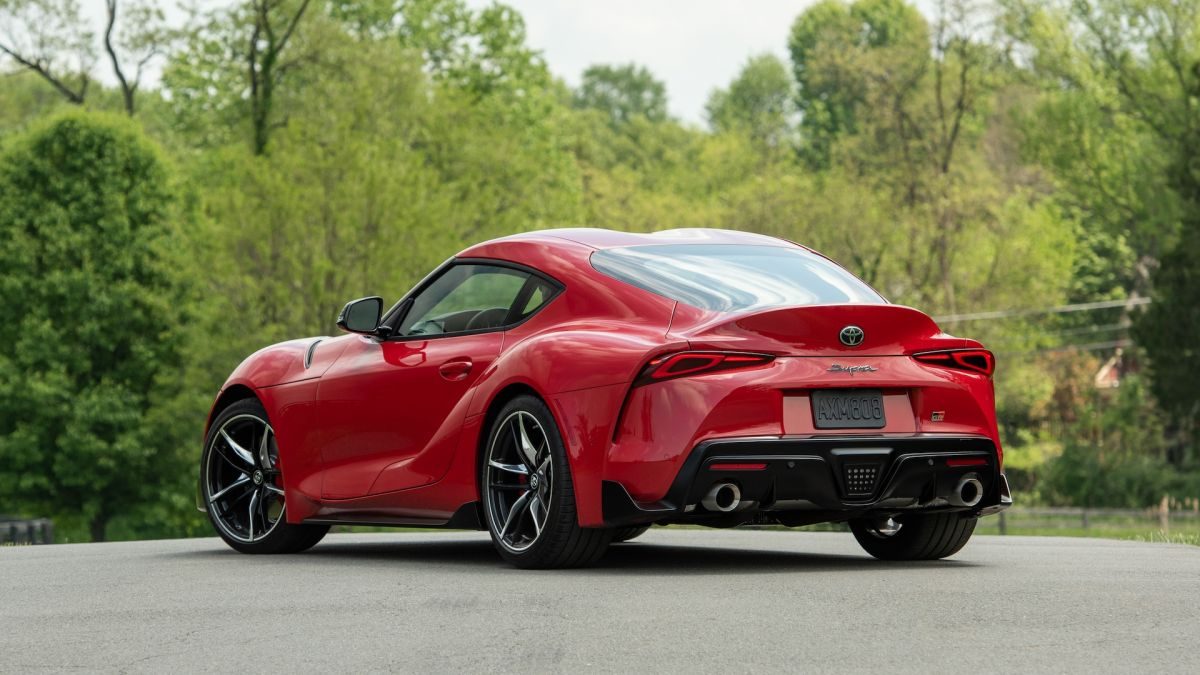 the crushing weight of expectation.
the crushing weight of expectation.
Amongst performance car enthusiasts the world over, the Mk4 Supra had evolved to become such an iconic car that its successor was expected to move the game ahead hugely in terms of power, style, performance, design and uniqueness. Disappointingly, when the final product was unveiled it became immediately apparent that Toyota had taken a much more reserved approach. The power increase was extremely modest, and the aesthetics – whilst sleek – were awkward and clunky from some angles. At the core of the issue was Toyota’s partnership with BMW, sharing not only the platform with the new BMW Z4 – limiting what they could achieve stylistically – but also the engine and much of the interior.
Of course, there was sound reasoning for going down this road. Toyota did not have a viable straight-six for use in a new Supra, so would have had to spend a trillion Yen developing one from scratch for a car that would only ever be sold in comparatively low volumes. BMW, on the other hand, had a proven and robust unit in the form of its B58, which replaced the N55 engine and had been used in the most recent M140i and M240i. The engine was arguably the easy sell; after all, the stock power output of the original 2JZ Supra Mk4 motor was never a headline maker – it was its durability and capacity for tuning that made it irresistible, so any new Supra could surely market itself on that same potential. What was harder for purists to swallow was stepping into the new Supra and being greeted by what looked to all intents and purposes like a Z4 interior. There were also concerns that the new Supra might end up driving just like a Z4 also, thanks to a number of key steering and suspension components being shared between both cars.
It didn’t help that its old stablemate – the Nissan GTR – had made huge waves with the mighty Godzilla-like R35. It didn’t help that 300bhp was now the baseline for even a hot hatch. It didn’t help that Toyota’s FT1 concept (which was what the Supra would eventually evolve from) looked much better than the production version. It didn’t help that the new Z4 had already been unveiled to less than glowing reviews.
Of course, the initial trepidation has now worn off and whilst purists haven’t quite rushed to embrace the car overnight, many have started to warm to it. Unlike the Z4, critical reviews of the Supra are for the most part very positive, praising the more involving suspension tune that Toyota have implemented. Some tuners have already realised substantial power gains and started releasing engine upgrades for it, suggesting a promising aftermarket life for the car just like its predecessor.
Mulling over this whilst reading a Supra review recently and choking on a cup of strong coffee, it struck me how important a name is. Had Toyota announced that they were releasing a new MR2, or even a new Celica, perhaps expectations would have been more tempered – expectations in line with a mid-level performance car. But this was the Supra; their flagship and a veritable automotive titan. Derived from the Latin word ‘Supra’ (which means “above”), the name immediately invoked certain thoughts and feelings in car fans and almost subconsciously you began to visualise what a successor might look like, how it might perform, how it might handle. And more often than not, these machinations placed it firmly into Nissan R35 and the new hybrid NSX territory at the least – not Porsche Cayman and BMW Z4 territory. In this age of immediate feedback from the web, a large swathe of the automotive community had already condemned the car before Toyota had officially unveiled it because they couldn’t fully reconcile the name with the product that Toyota were now presenting to them. Unfair, perhaps. But unexpected? In hindsight, probably not.
Does a car name thus imbue it with too much character and influence? Should it just be a label and nothing more? Take two very disparate manufacturer approaches, such as Aston Martin and BMW. A lot of Aston models have powerful, potent and charismatic names. The Vanquish. The Virage. The Vantage. The Volante. You can almost smell Bond’s musky scent from here. With typically Germanic and teutonic efficiency however, BMW – like Audi and Mercedes – use numerical codes and letters. The 320D. The A6. The C350. Spreadsheet indexing is obviously of more concern than virility amongst confident German car designers, but then again – perhaps their approach works. It could be argued that the BMW M3 in traditional two-door format is every bit as iconic as the Supra, yet when BMW decided to rename it as M4, there were a few brief grumbles …………… and then everyone quickly got with the program. It’s much less of a culture shock when simply shifting the number up by 1.
I like car names that have a meaning. It’s a confident statement by those behind the genesis of the car (with a little nudge from marketing perhaps) that they feel the car signifies something; that it has character, and isn’t just an exercise in bolting metal panels together. They’re 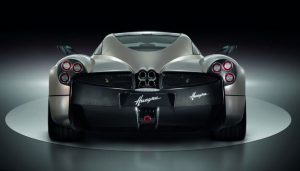 also memorable, but for the right reasons. You remember 320D with likely the same passion and fervour that you remember your bank pin code, but you recall a name like ‘Exige’ or ‘Tamora’ like an ex-girlfriend who still holds a special place in your heart. Like those cars, she was probably also a constant headache …………… but that’s beside the point.
also memorable, but for the right reasons. You remember 320D with likely the same passion and fervour that you remember your bank pin code, but you recall a name like ‘Exige’ or ‘Tamora’ like an ex-girlfriend who still holds a special place in your heart. Like those cars, she was probably also a constant headache …………… but that’s beside the point.
Italians often have a flair for names which invoke strong imagery, excitement and passion – as you might expect from a nation of self-described lovers. The Pagani Huayra for example derives its name from the Andean Wind-God, Huayra-tata, and it does indeed fly like the wind. The Lamborghini Aventador was named after a famous trophy winning bull, perfectly paralleling the raging bull logo which has adorned all Lamborghinis since 1963. ‘Stratos‘ was a Greek word meaning ‘Army’, and when Lancia chose it for their all-conquering rally hero, it seemed incredibly apt. They are not without a sense of humour too; the Alfa Romeo name Giulia is derived from Giulietta, a label they concocted almost by accident in the 1950s when a group of Alfa Romeo VIPs watched from a balcony as the all-male workforce exited the factory, and one made a tongue-in-cheek Shakespearean reference – “All those Romeos, and no Giuliettas”.
Some manufacturers also make a habit of theming their car names, which lends more credence to any PR attempts to sell the notion of their models forming a vehicular family of sorts. Take Rolls Royce – it’s no coincidence that their Wraith, Phantom and Ghost all invoke similarly spooky imagery. You too might get a fright when you see the PCP figures for one. Porsche are guilty of this also; somewhat peculiarly 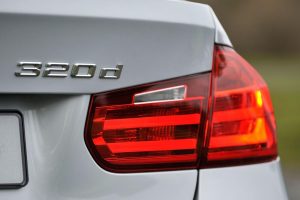 combining their typically German numerical model codes for some models with an obvious lust for Spanish-influenced words like Cayenne, Cayman and Carrera. Ford were also guilty of jumping on the Hispanic bandwagon, at one point having the Sierra, Fiesta and Granada on sale simultaneously. It remains to be seen if even one Granada driver ever felt remotely Spanish whilst doing the school run on a grey and wet UK Monday morning, but the Ford Misery would probably not have done as much for Dagenham’s coffers as the Granada did.
combining their typically German numerical model codes for some models with an obvious lust for Spanish-influenced words like Cayenne, Cayman and Carrera. Ford were also guilty of jumping on the Hispanic bandwagon, at one point having the Sierra, Fiesta and Granada on sale simultaneously. It remains to be seen if even one Granada driver ever felt remotely Spanish whilst doing the school run on a grey and wet UK Monday morning, but the Ford Misery would probably not have done as much for Dagenham’s coffers as the Granada did.
As the Supra has proven however, car names which have remained unchanged through multiple generations can also suffer from over-familiarity. This can have a positive effect on branding, on PR and on reassurance for repeat customers who often buy new editions of the same vehicles; but it can also have a dangerously negative effect in terms of generating genuine excitement and buzz, enticing new customers and allowing risk-averse manufacturers the freedom to make any substantial changes to their basic offering. The Volkswagen Golf is a prime example of this; now entering its 8th iteration, does anyone believe that VW would ever make any fundamental changes to the core principles which they design the Golf around? They are dropping the 3-door variant of course, but that’s a hatchback market paradigm that many manufacturers seem to be putting faith in.
With all of this said, the car industry is facing massive changes ahead as it begins to embrace electric power and the internal combustion engine as we know it begins to look increasingly archaic. With any such monumental shift comes fear and risk, and manufacturers’ PR and marketing strategies will be critically important in allaying customers concerns around the switch to electrification. Labelling, branding and naming methodologies will contribute hugely to these strategies. To date, a lot of the hybrid and electric variants of existing models have shared the same name, but with an ‘E’ or ‘i’ awkwardly tacked on to identify its designation – the i8, the Golf GTE, the Mercedes S560e, the E-pace. Going fully electric, it will be interesting to see what names are bandied around; will Lamborghini’s raging bull Aventador have the same metaphorical impact when there’s a set of silent electric motors turning the wheels in anger? Will a 320/330/340 badge make any logical sense on the rear of a BMW when its combustion engine no longer exists and any link to cubic capacity (which is admittedly tenuous at best at the moment) is completely severed?
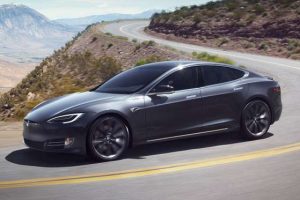 Look no further than Tesla for a refreshing approach to the inherently tricky conondrum of electric car naming, however. Too cheesy? Too long-winded? Too hard to pronounce? Too generic? None of these concerns apply any more. They’ve simply adopted the same approach Apple use for the iPhone, and given their models a single alphanumeric designation. The Tesla Model S. The Tesla Model X. The Tesla Model 3. The approach is beautiful in its simplicity and strangely synonymous with the evolution of cars from purely mechanical objects to their future potential as self-driving digital cocoons: more complicated underneath for sure, but packaged and presented as a simpler solution for getting us from A to B.
Look no further than Tesla for a refreshing approach to the inherently tricky conondrum of electric car naming, however. Too cheesy? Too long-winded? Too hard to pronounce? Too generic? None of these concerns apply any more. They’ve simply adopted the same approach Apple use for the iPhone, and given their models a single alphanumeric designation. The Tesla Model S. The Tesla Model X. The Tesla Model 3. The approach is beautiful in its simplicity and strangely synonymous with the evolution of cars from purely mechanical objects to their future potential as self-driving digital cocoons: more complicated underneath for sure, but packaged and presented as a simpler solution for getting us from A to B.
Take note Toyota. If you think the Supra Mk5 had it hard, the iSupra won’t know what hit it.



